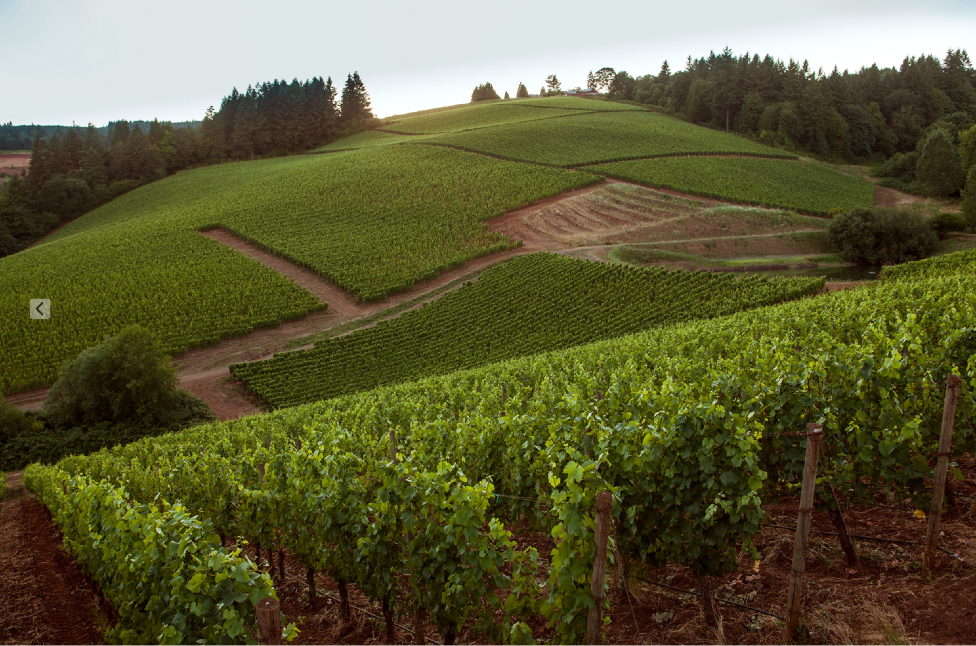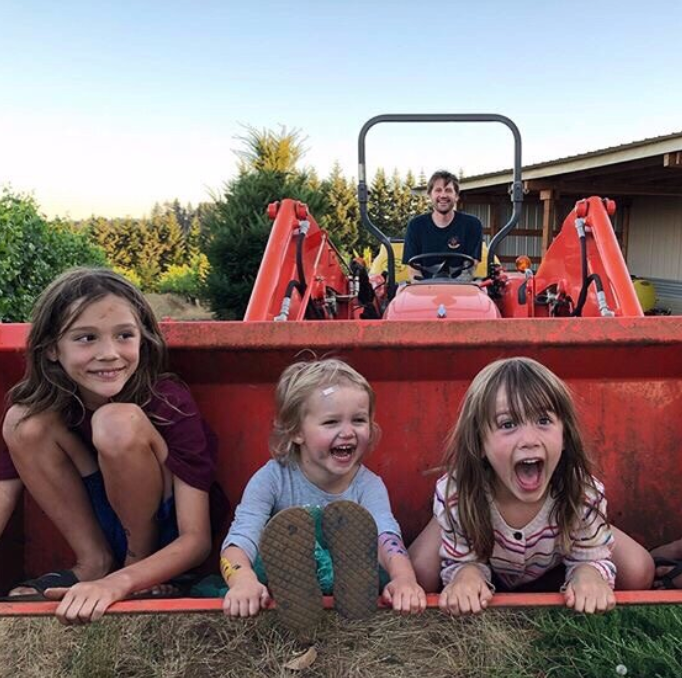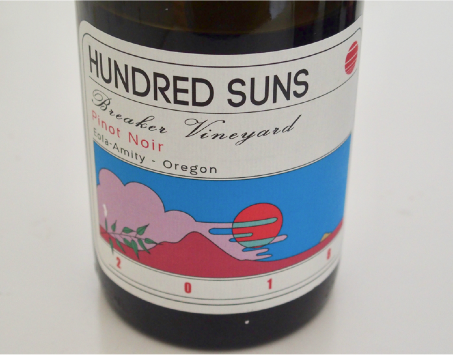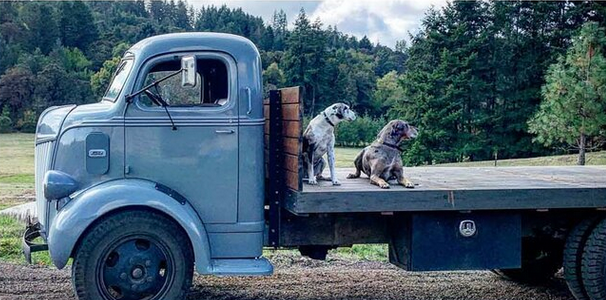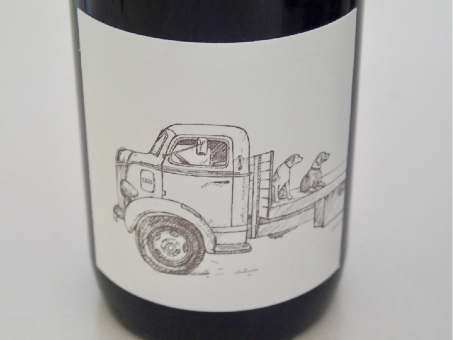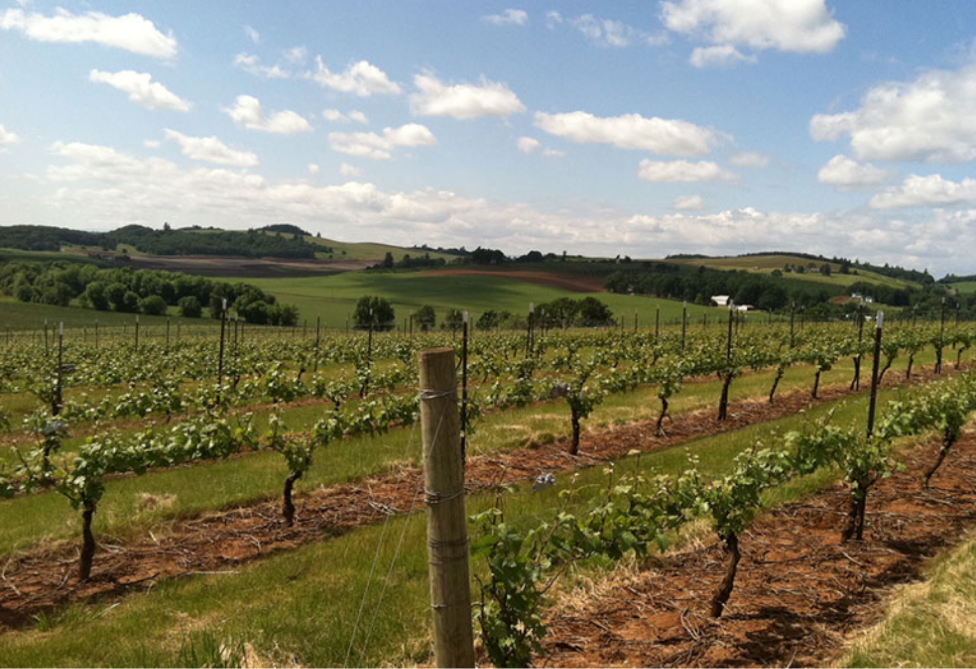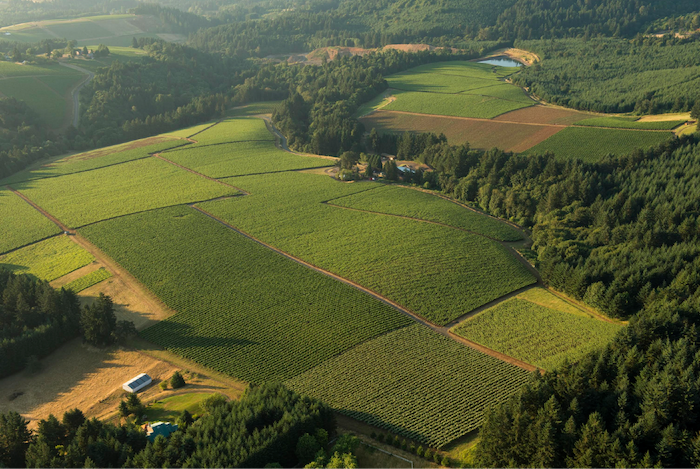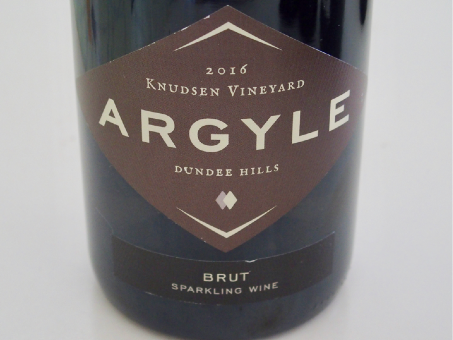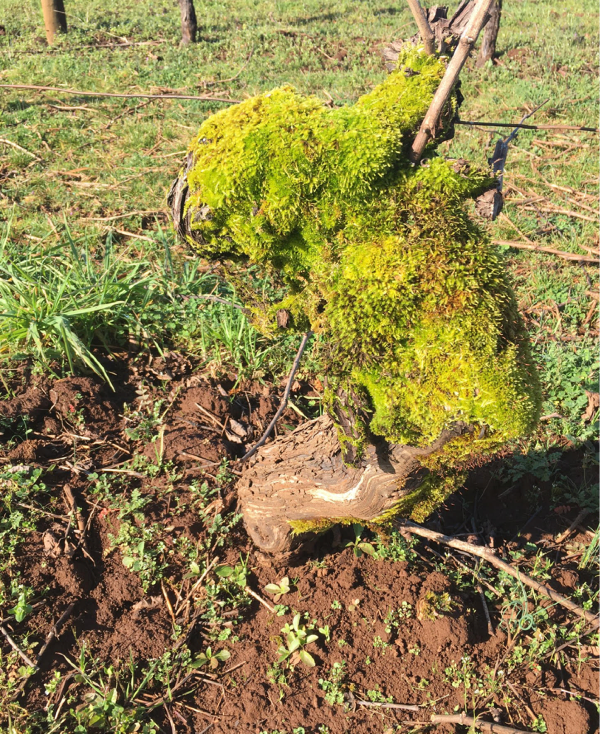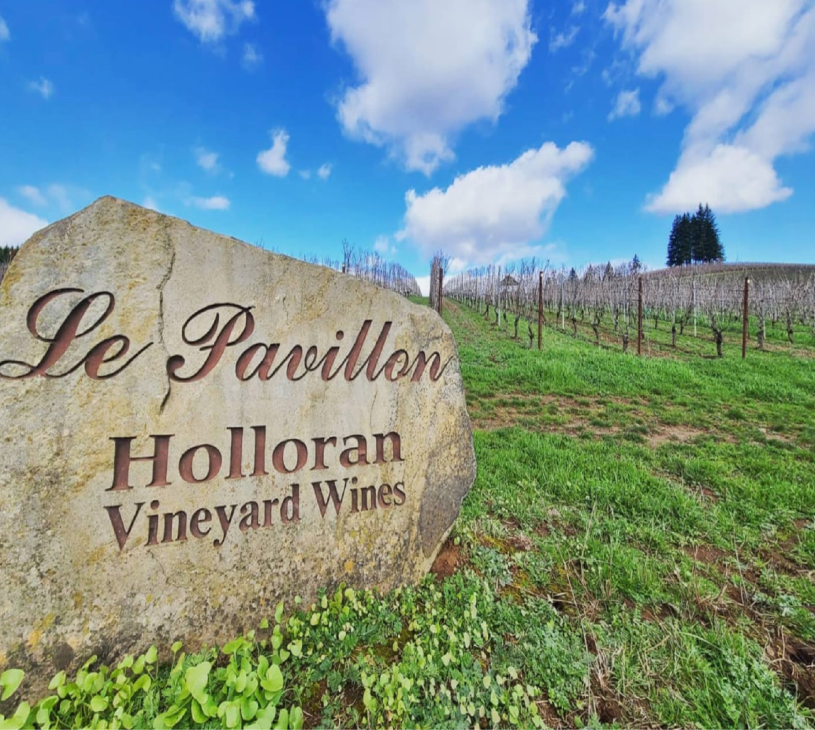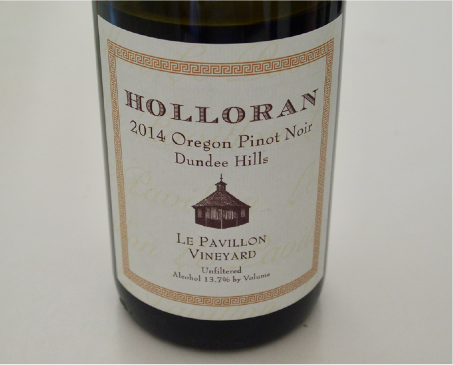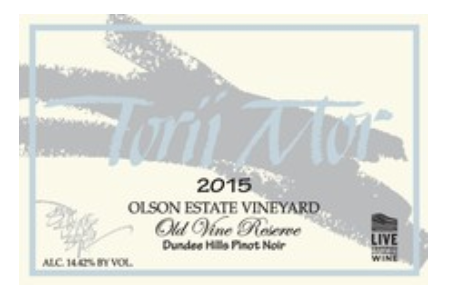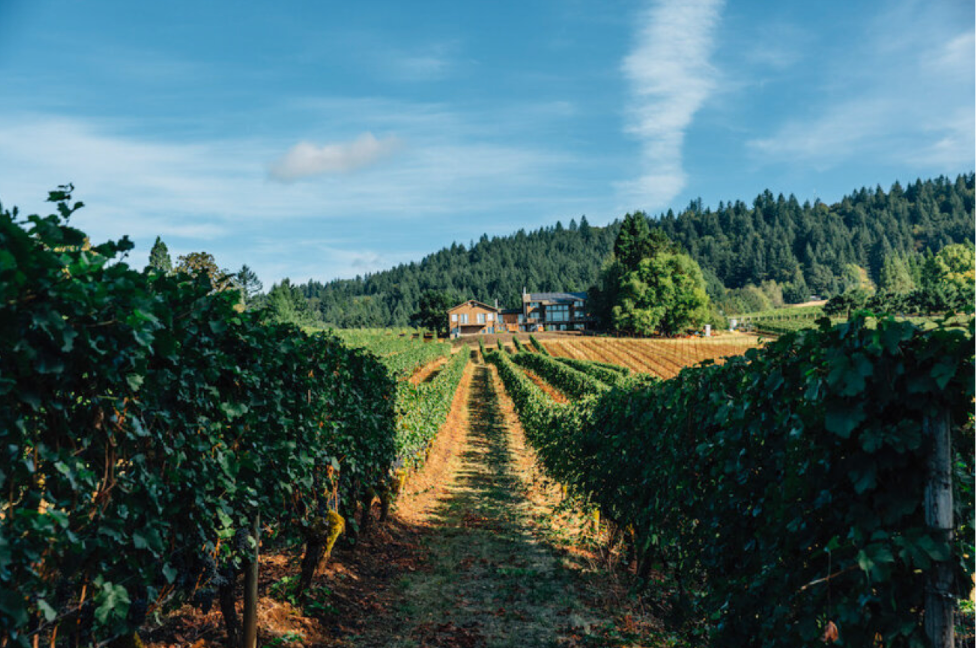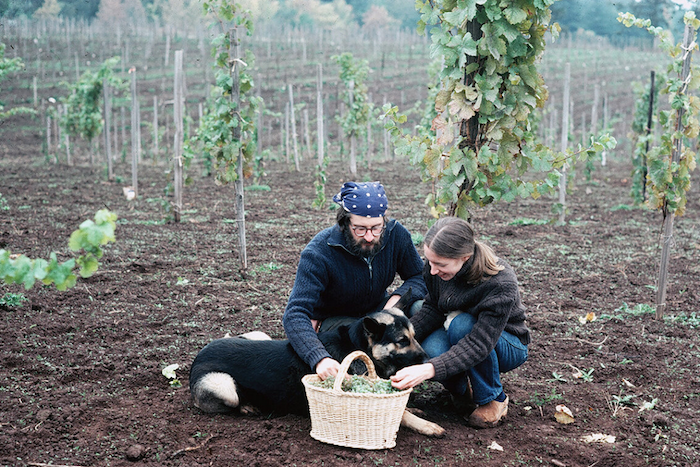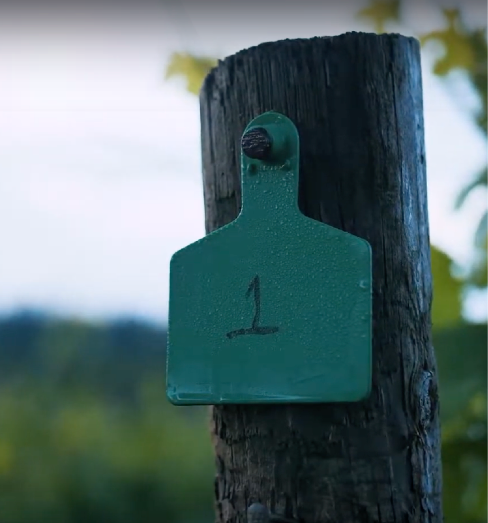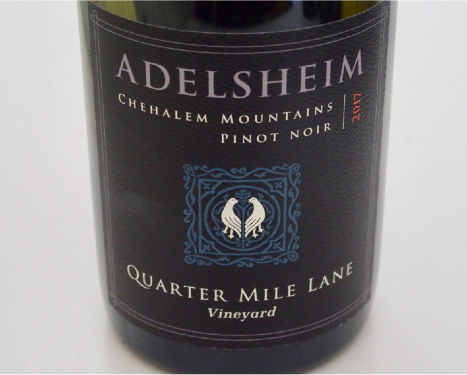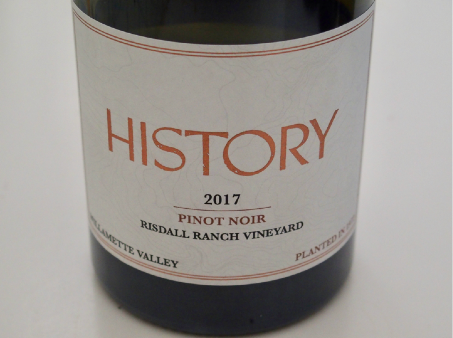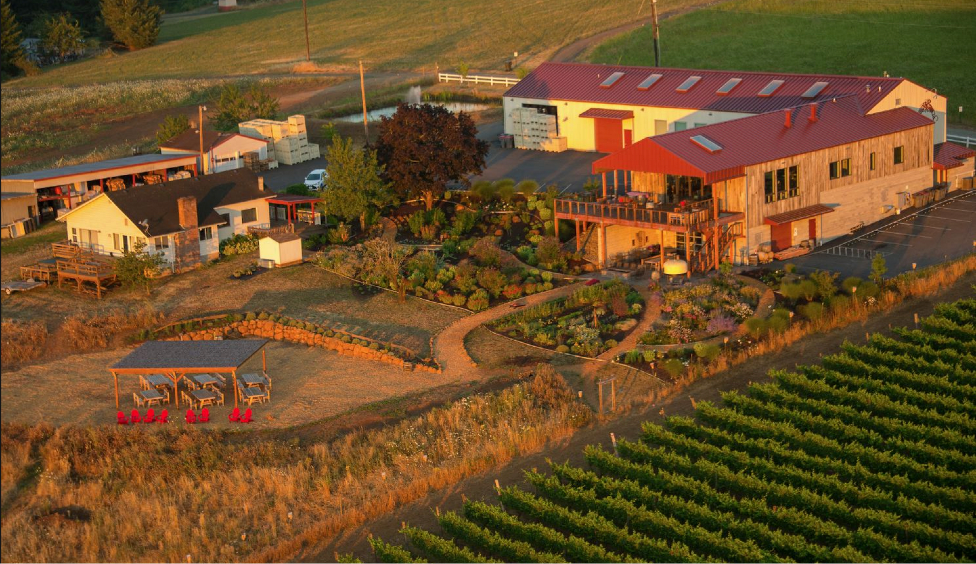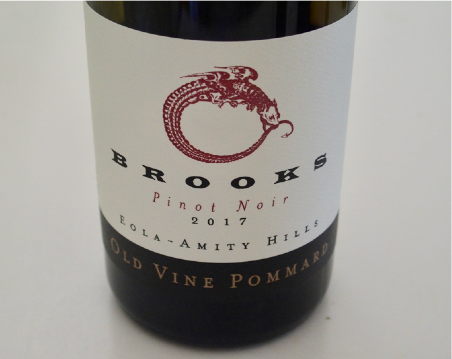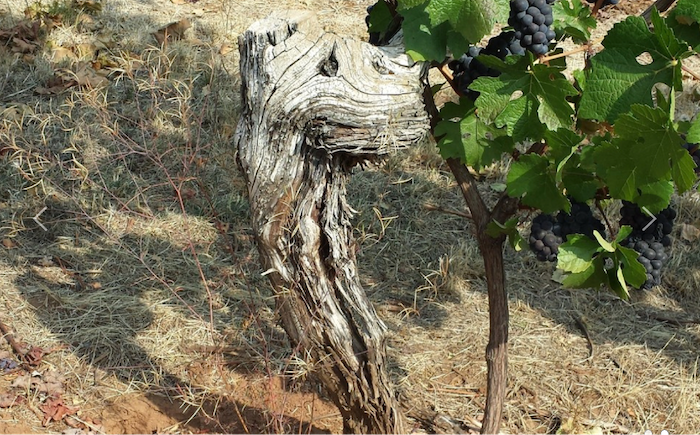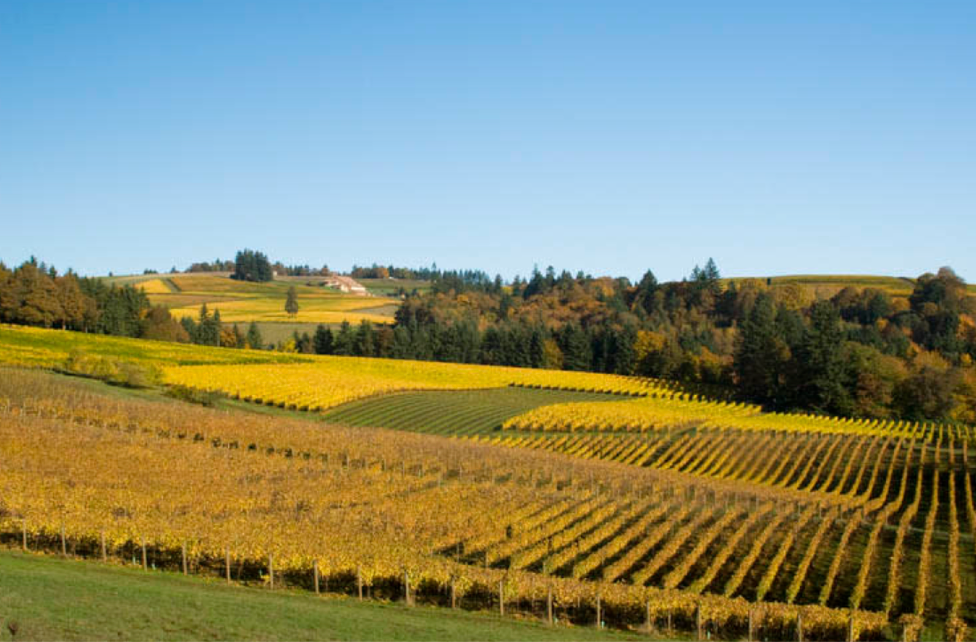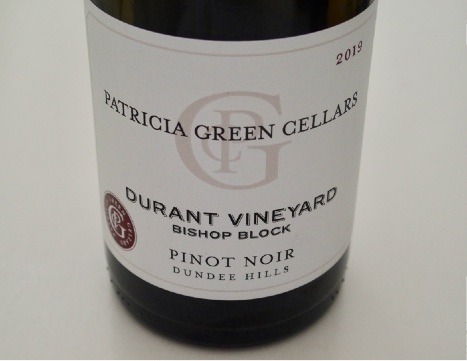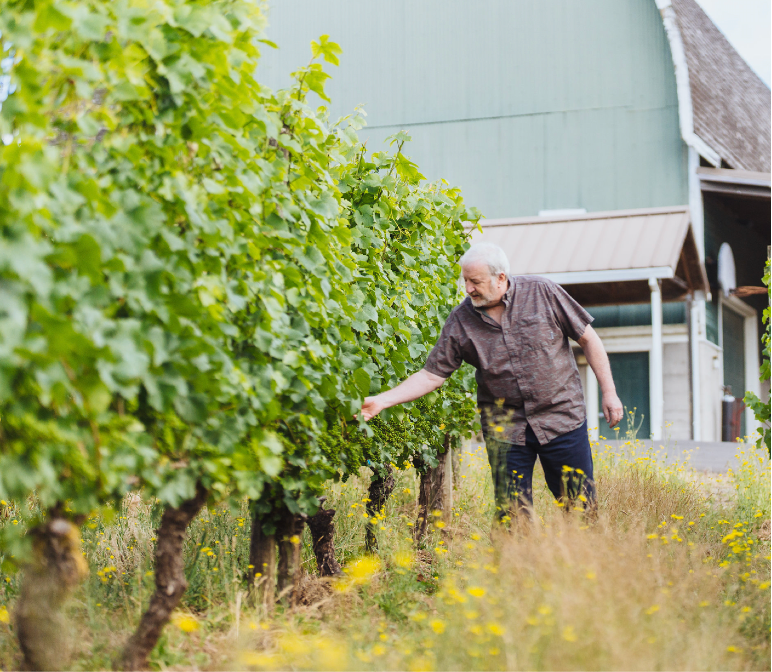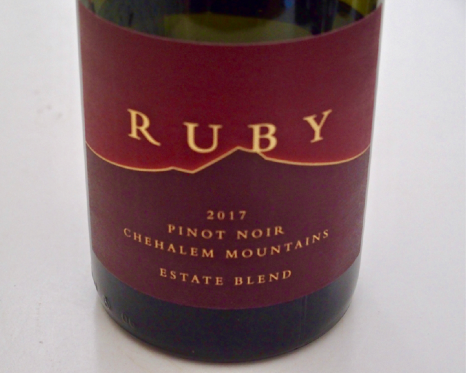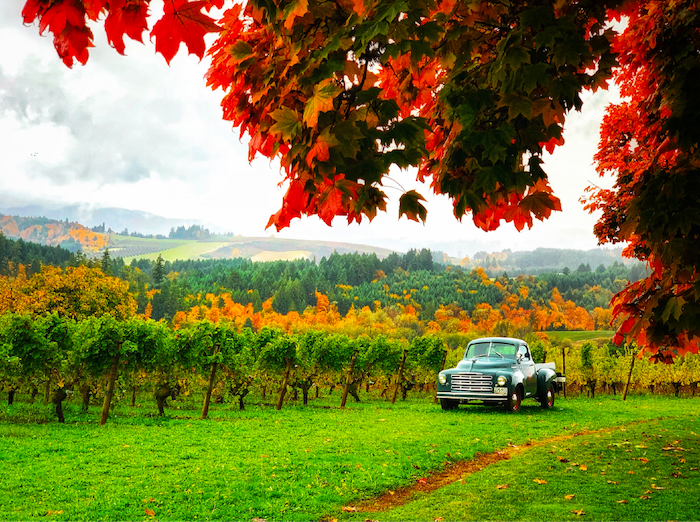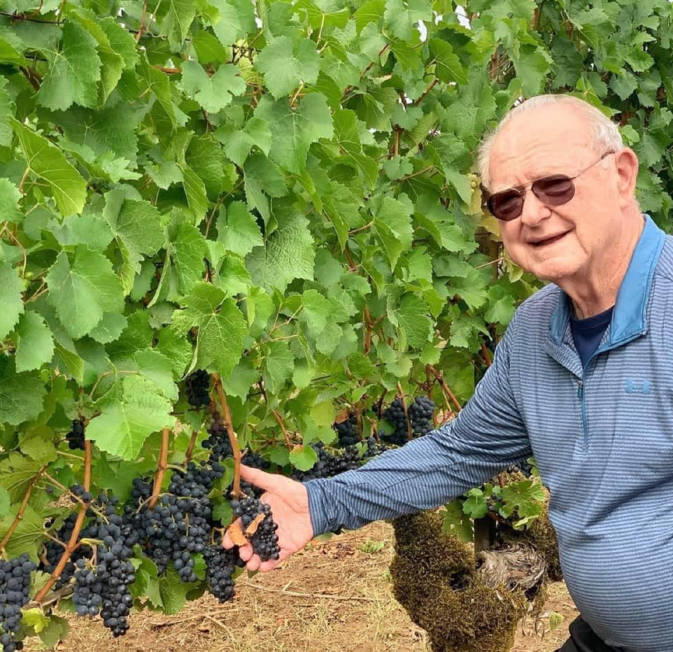Own-rooted Pommard.
Soil: A volcanic mosaic of shallow and rocky benches and slopes formed over many millennia from
innumerable lava flows (red, volcanic Jory loam).
Vines: The original vines are southeast-facing at 900’ elevation (the entire vineyard ranges from 500’ to 1000’
elevation.
Farming: The entire vineyard was retrofitted with drip irrigation in every row in 1988 and 1990. LIVE certified
and Salmon Safe. The vineyard manager is Mark Sheridan.
Winery clients: Argyle
Old vine bottling: Argyle produces a Knudsen Vineyard Brut Sparkling Winesourced exclusively from
Block 2 at Knudsen Vineyards. Knudsen Vineyards produces Pinot Noir with fruit from Block 2 in the blend but
not as a stand-alone wine. Another producer is scheduled to craft wine from Block 2 for the first time from the
2021 harvest.
Of interest: The Knudsen Vineyard now encompasses 130 planted acres, 73% of which isPinot Noir, with a
mix of older vines and newer, high-density blocks planted to Dijon clones in the 1990s. The Knudsen Vineyards
Winery was launched in 2013 with a Pinot Noir from the 2012 vintage.
2016 Argyle Knudsen Vineyard Dundee Hills Brut Sparkling Wine
12.5% alc., 932 cases, $50. 100% Pinot Noir from 42-
year-old Pommard vines. Harvest Brix 19º. Barrel aged in
mature oak. Disgorged in March 2020 followed by dosage of
0.5% residual sugar.
·
Platinum color with a tinge of pink in the
glass. Lovely aromas of white peach, lime, lemon zest and
subtle yeast. Focused flavors mimic the nose. A cheerful, dry
wine with good mousse, excellent crispness and a refreshing
finish of excellent length. This wine should hold its own over
several more years.
Score: 93
Saucy/Juliard/Furioso Vineyard
Furioso Vineyard
Owners: Tom and Sharon Saucy bought 10 acres in the Dundee Hills in 1971 and planted a 9-acre vineyard.
They purchased the property from Dr Smith, a Linfield College instructor. The vineyard was sold to Julia
Staigers and Gerard Koschal in 1987, and they renamed it Juliard Vineyard. They established the Crumbled Rock
brand and replaced much of the existing vineyard (except for Riesling) with Pinot Noir in the late 1980s
and the 1990s, while adopting a more serious approach to managing the vineyard. The property was acquired by
Giorgio Furioso in 2014, renamed Furioso Vineyard, and the inaugural wines were released from the 2015 vintage.
Location: On NE Worden Hill Road, ¼ mile from Winderlea Vineyards & Winery.
Old Cabernet Sauvignon vine grafted to Pinot Noir at Furioso Vineyard
Plantings: The initial 1972 planting included an eclectic and randomly-planted number of varieties including
own-rooted Pommard Pinot Noir. The vineyard was born somewhat by accident by owners who just wanted to
try something different. Early planting continued until 1977. As Pinot Noir became the most commercially viable
variety, many of the original vines were either grafted or replaced. The vineyard grew from a couple of acres to
8 acres today with the majority of the vines being own-rooted Pommard clone. According to Furioso winemaker
Dominque Mahe, there are a few original Pommard vines here and there in the vineyard and about 4 to 5 acres
of Pommard replants.
Pinot Noir scion: Own-rooted Pommard clone.
Soil: Volcanic Jory.
Vines: South-sloping parcel at 400’-502’ elevation. The initial 1972 planting had 10’ row spacing.
Farming: Transitioned to organic farming in 2019 while working towards organic certification. No-till farming.
Winery clients: Arterberry Maresh, Winderlea.
Old vines bottlings: None strictly from original plantings.
Le Pavillon Vineyard
Le Pavillon Vineyard
Owner: Holloran Vineyard Wines (Bill and Eve Holloran)
Location: On Worden Hill Road in the Dundee Hills AVA
Planting: Initial planting of 8.8 acres of own-rooted Pommard Pinot Noir, Chardonnay, and Riesling between
1972 and 1974. Now a 10-acre site, with 5.2 acres of Pinot Noir, including some Dijon 114, 1.5 acres of
Riesling (Geisenheim 110), 1.6 acres of Chardonnay (Draper selection), and .5 acres of Pinot Gris.
Pinot Noir scion: Own-rooted Pommard.
Soil: Volcanic Jory, Gelderman, and Rittner.
Vines: Primarily south-facing at 580’-680’ elevation and a 9.7% slope. 9’ between rows.
Farming: Organic since 1999 and biodynamic since 2006. Dry-farmed
Winery clients: Et. Fille and J. Christopher.
Old vines bottlings: Holloran Vineyard Wines Le Pavillon Pinot Noir is listed as produced recently in 2014,
2016 and 2017.
Of interest: From a release of 500 cases of Pinot Noir, Riesling and Chardonnay in 1999, the winery and
vineyards have been expanded as has the case production that is now between 5,000 and 6,000 cases. Mark
La Gasse has been the winemaker since 2005.
2014 Holloran Le Pavillon Dundee Hills Pinot Noir
13.7%
alc., $45.
·
Moderate garnet color in the glass. A slightly
confected nose offers aromas of cherry pie and sandalwood.
Light to mid-weight in style, featuring a bright core of dark red
and blue berries backed by fine tannins and juicy acidity.
Discrete, without overreaching, exhibiting Pinot’s gracefulness.
Quintessential Dundee Hills character.
Score: 93
McDaniel Vineyard/Olson Estate Vineyard
Owners: Jim and Donna Jean McDaniel purchased land in the Red Hills above Dundee in 1972 and moved
their family from McMinnville to start McDaniel Vineyard. Jim was the first person to assist David Lett in making
his first vintage. Grapes from McDaniel vineyard were sold to multiple area wineries. In 1985, the vineyard and
home were sold to Dr. Donald Olson who renamed the vineyard Olson Estate Vineyard and started Torii Mor
Winery (first vintage in 1993).
Location: Worden Hill Road in the Dundee Hills AVA.
Planting: The initial planting of 10.19 acres in 1972 included Pinot Noir, Upright Pinot, Chardonnay, Riesling,
Muscat, Pinot Gris, and Sauvignon Blanc. Own-rooted vines were obtained from Erath and Coury. Currently,
the vineyard has 6.5 acres of Pinot Noir still in production with 1 acre of Pinot Gris. In 2002, 1.7 acres of
Chardonnay were grafted to 667 and a small planting of Upright Pinotwas grafted to 114.
Pinot Noir scions: Own-rooted Pommard, Wädenswil, Upright Pinot, and Coury selections.
Soil: Volcanic Jory.
Vines: South-facing at 815’ elevation. Spacing is 9’ x 6’ with a double Guyot trellis (VSP).
Farming: Organic and LIVE certified.
Winery clients: None, a monopole.
Old vines bottlings: Torii Mor Olson Estate Vineyard Pinot Noir is a blend of old vine Coury selection,
Pommard, Upright Pinot, and Wädenswil, and Dijon 667. A Torii Mor Olson Estate Vineyard Old Vine
Reserve Pinot Noir ($125) is from 100% original own-rooted vines is also available. The 2018 vintage is in
production and will be offered soon.
Quarter Mile Vineyard
Quarter Mile Lane Vineyard
Owners: In 1971, David and Ginny Adelsheim purchased 19 acres in the Chehalem Mountains. The following
year, Quarter Mile Vineyard was planted, Adelsheim’s first estate vineyard. The current owner of Adelsheim
Vineyard (including Quarter Mile Vineyard) is Lynn Loacker.
Location: Chehalem Mountains AVA.
Planting: Block 1, 2.39 acres, remains the original plantings from 1972, but the remainder of the vineyard has
been replanted. The entire vineyard is now 14.83 acres and includes Pommard UCD 5, AS-2 selection and
QM-1 along with Dijon 667, 777 and 4407 selections of Pinot Noir, and Dijon clone 76 Chardonnay.
David and Ginny Adelsheim planting Quarter Mile Vineyard
Pinot Noir scion: A proprietary, own-rooted blend called “Quarter Mile 1 Selection or QM-1” since the scion is
unknown. The original plantings were obtained from Charles Coury and initially believed to be Pommard. Over
time, it has become clear to David Adelsheim that the vines are not Pommard (full explanation on page 105).
Block 1, Quarter Mile Vineyard
Soil: Volcanic.
Vines: South-facing at 560’-680’ elevation. 9’ x 6' spacing, VSP trellis.
Farming: LIVE certified and Salmon Safe.
Winery clients: None, a monopole.
Old vines bottlings: Adelsheim Quarter Mile Lane single-vineyard Pinot Noir wines are sourced from the
original Block 1. To celebrate Adelsheim’s 50th Anniversary, the winery released 140 collectible magnums from
the 2019 vintage with a special commemorative label called “The Deed”. The wine was crafted by Gina
Hennen who claims, “It is unlike any other wine we have made before.” The label design is inspired by the
original Land Deed from 1971. The wine is sourced exclusively from the oldest vines at Block 1 of Quarter Mile
Vineyard. The wine was released in June 2021 and sold for $300.
2017 Adelsheim Quarter Mile Lane Vineyard Chehalem Mountains Pinot Noir
13.5% alc., $125.
·
Light ruby color in
the glass. Gracious aromas of red cherry, strawberry,
sandalwood and sous-bois building in intensity over time in the
glass. Lighter weighted with gentle power, featuring flavors of
red berry and cherry fruits with a savory herbal note. The
discreet fine tannins partner with a satisfying juicy grip of
acidity on the finish that is of generous length.
Score: 93
Shafer Vineyard/Risdall Ranch
Owners: Harvey Shafer planted Pinot Noir in Forest Grove in 1972. In late 1978 (also reported as 1981),
Shafer ceased selling his grapes and began making his own wine under the Shafer Vineyard Cellars label. He
became well known for growing quality Pinot Noir. Dr. Robert Risdall and his son Emery Risdall moved from
Northern California in 2015 to purchase Shafer Vineyard Cellars from then-owners Jerry and Miki Kramer. The
vineyard was renamed Risdell Ranch. Dr Risdall became ill in 2017 and the winery was closed permanently in
December 2018.
Location: Just northwest of Forest Grove in the Tualatin River Valley (now the Tualatin Hills AVA).
Planting: Shafer planted the first own-rooted Pinot Noir and Upright Pinot vines in 1972 on a slope once used
for strawberry cultivation. He eventually added Sauvignon Blanc, Müller-Thurgau, Gewürztraminer, Riesling,
Chardonnay, and Pinot Gris. The vineyard grew to 30 acres.
Pinot Noir scions: Unknown.
Soil: Silty clay loam
Vines: Southwest exposure at 350’ elevation.
Farming: Dry-farmed and sustainably worked by the Risdall family.
Winery clients: Fossil & Fawn, Maloof Wines, Stedt Wines (Pinot Gris) and Stoller Family Estate. Melissa
Burr, Vine President of Winemaking at Stoller Family Estate in Dayton, began purchasing grapes from the
Risdalls in 2016 for the winery’s line of History wines made from
historic vineyards in Oregon and Washington.
Old vines bottling: Stoller Family Estate History Pinot Noir.
2017 History Risdall Ranch Vineyard Willamette Valley Pinot Noir
14.2% alc., 61 cases, $55.
·
Light garnet color in the
glass. Aromas of black cherry, tilled earth and bright roseate
scent. Very silky on the palate with an array of delicious flavors
including red cherry, red raspberry, strawberry, cola, spice, and
a shadow of oak. Impeccable harmony with gossamer tannins
and an extremely long finish. A real old vine treasure.
Score: 94
Hinman Vineyards
5 acres of vines, including Pinot Noir, Upright Pinot, Riesling, Gewürztraminer, Zinfandel, and Merlot were planted in
1972 and 1973 by Doyle Hinman, David Smith, and other partners in the hills outside of Eugene. The vineyard was
replanted in 1975 due to weather damage (mildew). A winery was first opened in 1979 and by 1988, became
Oregon’s top-selling winery. Wines were also released under the Sylvian Ridge label. Carolyn Chambers, a Eugene
businesswoman acquired the winery in 1991 and her daughter assumed ownership with Carolyn’s passing in 2012. I
could not find a history of recent old vine botttlings.
1973
Eola Hills Vineyard/Brooks Estate Vineyard
Brooks Winery and Estate Vineyard
Owners: The vineyard was originally known as Eola Hills Vineyard when Don Byard planted it. Byard was one
of Oregon’s little known original winegrowing pioneers. He and his wife Carolyn purchased a 20-acre orchard in
1973 and began replanting the property with grapevines from 1973-1974. Winemaker and founder of Brooks
Wine, Jimi Brooks, found this vineyard while pursuing an old vine Riesling vineyard and found that this
vineyard had 5 acres of Riesling in addition to Pinot Noir. Brooks Wine purchased the vineyard in 2008.
Location: Eola-Amity Hills AVA.
Planting: Byard and his family planted 5 acres of own-rooted Pommard clone Pinot Noir and 5 acres of
Riesling in 1973 to 1974 followed by 0.9 acres of Pinot Gris in 1979. Another 9 acres of Dijon clones 777 and 115
followed in the late 1990s on grafted rootstock. Byard’s label was Hidden Springs. Currently, there are 18.5
acres of vines including 13.5 acres of Pinot Noir (the original Pommard plus Pommard, 115, and 777 planted
on rootstock in the late 1990s). There has been limited vine replacement plantings.
Pinot Noir scion: Own-rooted Pommard.
Soil: Volcanic Jory and Nekia series.
Vines: Southeast-facing parcel at 650’-750’ elevation with a modest slope. 9’ x 5’ spacing was laid out
originally. VSP trellis.
Farming: Converted to biodynamic farming between 2002 and 2004 and certified Demeter® in 2012. Jessica
Cortell of Vitis Terra Vineyard Services farms the site.
Winery clients: None, a monopole.
Old vines bottlings: Brooks Wine Old Vine Pommard Pinot Noir
Of interest: Pascal Brooks inherited the winery at the age of eight when his father, Jimi Brooks, unexpectedly
passed away. Pascal currently resides in France where he has worked on several harvests and is devoted to
greening projects. Janie Brooks Heuck (Jimi’s sister) is the current Managing Director of Brooks Wine. Chris
Williams, a friend of Jimi’s since the 1990s, has been the winemaker since 2005. I have tasted the range of
Rieslings from this winery and can highly recommend them. Winemaker Chris Williams is a Riesling aficionado.
2017 Brooks Old Vine Pommard Eola-Amity Hills Pinot Noir
13.5% alc., 300 cases, $60. Sourced from the original 1973
plantings of own-rooted Pommard clone located in the heart of
the Brooks Estate Vineyard.
·
Light garnet color in the glass.
Grounded aromas of dark red and black cherry, dried rose petal
and sassafras. Light to mid-weight in style and largely red
fruited with an interesting savory herb and earthy component.
The polished tannins give a silken texture and the energetic
acidity leads to a quenching finish.
Score: 93
Durant Vineyards Bishop Block
Old vine Pinot Noir at Durant Vineyard
Owners: Ken Paul and Penny Durant
Location: Durant Vineyards at Red Ridge Farms is on NE Breyman Orchards Road at the southern end of
the Dundee Hills in the Dundee Hills AVA. The vineyard is adjacent Domaine Drouhin, De Ponte, and Sokol
Blosser.
Planting: The vineyard was planted in 1973 by the same family that owns and farms the vineyard today. A
bulk of the initial planting is still productive. The oldest planting is a 5-acre black of own-rooted Pommard clone
named the Bishop Block. The current 50-acre Durant Vineyard consists of several different plantings of Pinot
Noir and other varieties including Chardonnay and Pinot Gris.
Durant Vineyards
Pinot Noir scion: Own-rooted Pommard.
Soils: Volcanic Jory.
Vines: Mostly south-facing at an elevation of 200’ - 600’
Farming: Sustainably.
Winery clients: Patricia Green Cellars is the sole client for the Durant Vineyard Bishop Block Pinot Noir.
Old vines bottling: Jim Anderson, co-owner and winemaker for Patricia Green Cellars, says, “The fact that
this site and the Patricia Green Cellars Durant Vineyard Bishop Block Pinot Noir exist at all is somewhat of
a miracle. The wine knows exactly what it wants to be. It shows finesse, subtleness, elegance and discreet
balance all backed up by a sneaky and looming firmness. Only older vines make wines like this.”
Of Interest: The Durant family’s history in the Willamette Valley now spans 5 generations and began with
English walnuts, hazelnuts, Italian prunes and cherries. Olives were planted in 2004, one of the first orchards in
Oregon, and the Durant Olive Mill is the only commercial olive mill in Oregon.
2016 Patricia Green Cellars Durant Vineyard Bishop Block Dundee Hills Pinot Noir
14.0% alc., $45.
·
Moderately dark garnet color in the glass. Reserved, but pleasing aromas of black cherry and earthy flora. A
flood of luscious, well-spiced, black cherry and purple berry fruit flavors engage the palate with authority. Plush
in texture, with reserved tannins and a faint note of oak in the background. The finish is incredibly long,
exceeding almost every every other old vine bottling tasted for this article. Flat-out terrific when tasted the
following day from a previously opened bottle.
Score: 96
2019 Patricia Green Cellars Durant Vineyard Bishop Block Dundee Hills Pinot Noir
13.3% alc., $48. the bulk of this
Block remains the original planting done in 1973 by the Durant
family.
·
Moderately dark garnet color in the glass. Glorious
aromas of earthy black cherry, raspberry, spice and rose petal.
Deep cherry flavor with added tastes of red current and iron. A
complete wine that is very generous through the mid palate
and finish, with silken tannins and blessed acidity. Still
exceptional when tasted two days later from an opened bottle.
Score: 95
Leroy Vineyard
Owners: Leroy and Kathy Nelson have owned this vineyard since 2019.
Location: South of Hillsboro in the Chehalem Mountains AVA, near DION Vineyard.
Planting: Original planting of Pinot Noir in 1973 but interplanting has gone on after the original owners sold
the vineyard in 1999.
Pinot Noir scions: Own-rooted Pommard, Wädenswil and rooted faux 828 (AS2).
Soil: Laurelwood.
Vines: The vineyard is heavily shaded on the west side so it is very susceptible to mildew. 300’ elevation. 10.5’
x 7’ vine spacing.
Farming: Attempts at organic farming have largely failed, but LIVE management has succeeded. The
vineyard has been farmed for many years by Kevin Dion and his crew of DION Vineyard.
Winery clients: DION Vineyard, Roots Wine Company.
Old vines bottlings: The grapes have been used by DION Vineyard for both sparkling and still wines, and in
2020 was incorporated into the DION Home Vineyard Old Vines bottling. Roots Wine Company has bottled a
Leroy Vineyard designated Pinot Noir in some vintages.
Beran Vineyards/Ruby Vineyard
Owners: The initial owners were John and Beth Hiestand who planted the first vines in 1973 ( or maybe 1972).
Bill Beran and his wife acquired the property in 1979. Beran, who added plantings in 1979, 1999 and 2000,
converted the dairy barn on the property to a winery and launched Beran Vineyards & Winery with the first
vintage in 1997. Beran Vineyards was sold to Steve Hendricks and Flora Habibi in 2012 who renamed the
vineyard Ruby Vineyard after Flora’s favorite gemstone and released the first vintage in 2015.
Location: 8 miles south of Hillsboro in the Chehalem Mountains AVA.
Planting: .25 acres of own-rooted Wädenswil 1A were planted in 1973 with cuttings from the South Block of Eyrie
Vineyard. The cuttings were rooted adjacent the property’s barn and were planted the following year. 3 acres of own-rooted
Pommard Pinot Noir, 1.5 acres of Riesling and 1.5 acres of Chardonnay acquired from Erath’s nursery
were planted in 1979. In 1999, the Riesling and Chardonnay was field grafted to Dijon 115 Pinot Noir.
Additional Pommard 4 was planted in 2000. Currently, there is a total of 7.25 acres of own-rooted Pinot Noir.
There have been vine replacements with cuttings taken from the original Wädenswil 1A plantings.
Pinot Noir scions: Own-rooted Wädenswil 1A and Pommard.
Steve Hendricks and Ruby Vineyard old vine Pinot Noir
Soil: Laurelwood.
Farming: Dry-farmed and committed to organic practices since 2013. LIVE certified since 2017.
Winery clients: None, a monopole
Old vines bottlings: Ruby Estate Blend Pinot Noir from the 1979 and subsequent plantings and Ruby
Flora’s Reserve Pinot Noir from the 1973 planting (about 2 barrels produced each year).
Of interest: Abijah Hendricks homesteaded the property after arriving on a wagon train in 1843. His greatgreat
grandson, Stephen Hendricks, a lawyer and fifth generation Oregonian, returned to his roots in the Willamette Valley and acquired the Beran Vineyard and Winery.
2017 Ruby Estate Blend Chehalem Mountains Pinot Noir
13.3% alc., $50. Sourced from own-rooted vines planted in
1979 (Pommard), and Wädenswil and Dijon 115 clones.
Indigenous yeast fermentation.
·
Light garnet color in the glass.
Plenty of cherry pie goodness on the nose soaring over time.
Vibrant cherry and raspberry fruit flavors with integrated
tannins, a silky mouthfeel, a touch of oak and a very satisfying
finish. A real cherry delight.
Score: 93
2017 Ruby Flora’s Reserve Chehalem Mountains Pinot Noir
alc., $125. Own-rooted Wädenswil 1A
vines dating to 1973. 100% de-stemmed, native yeast fermentation, aged 10 months in neutral French
barriques and puncheons.
·
Light garnet color in the glass. Delicate aromas of cherry, strawberry, sous-bois,
graham and cardamom building in intensity over time in the glass. My notes say “amazing nose.” Considerably
more power and palate presence than the light color would suggest. Replete with cherry goodness married to
gossamer tannins. More elegant and lacy than the Estate Blend, with an extremely long, and I mean long,
finish.
Score: 96
Tualatin Estate Vineyard
Tualatin Estate Vineyard
Owners: Investment banker Bill Malkmus and enologist William Fuller acquired a 65-acre property near Forest
Grove in 1972 and founded Tualatin Valley Vineyards in 1973 when they planted a vineyard. Fuller grew up in
California’s Central Valley and worked in the lab at Italian Swiss Colony, earned an MS in enology from UC
Davis, and was a winemaker for Louis M. Martini for nine years. He became one of the most respected
winemakers in Oregon and Tualatin achieved widespread recognition as a premium wine brand, mainly for
Chardonnay. The vineyard was sold to Willamette Valley Vineyards in 1997 and the Tualatin Winery closed in
1999. Beginning in 2013, Fuller began consulting at Willamette Valley Vineyards where he was mainly
responsible for wines using fruit from Tualatin Vineyard.
WIlliam Fuller
Location: 6 miles northwest of Forest Grove and 30 miles west of downtown Portland in the Tualatin Hills
AVA. Nearby wineries include David Hill, Elk Cove, and Montinore.
Planting: The initial planting in 1973-1974 included 14.5 acres of own-rooted Pommard clone, 4.1 acres of
own-rooted Chardonnay, and 4.8 acres of own-rooted Gewürztraminer. There has been no interplanting or
supplemental planting in the old blocks and all the original Pommard is still in production. There has been
replanting to higher density in some portions of the vineyard and new blocks have been developed over time.
45 acres of Pinot Noir have been planted to Dijon clones 113, 114, 115, 667 and 777 onto phylloxera-resistant
rootstock. The new plantings are spaced at twice the plant density of the original vineyard. Tualatin Estate
Vineyard now has 171 planted acres including Pinot Noir, Chardonnay, Riesling, Gewürztraminer, Muscat and
Pinot Blanc.
Pinot Noir scion: Own-rooted Pommard.
Soils: Laurelwood over deep Jory clay with concretions called pisolites.
Vines: South-facing with north/south row orientation at 250’-530’ elevation. All vines are VSP or arched trellis
style. Old vine spacing is 10’ x 7’ and 12’ x 6’.
Farming: Dry farmed and LIVE and Salmon-Safe certified. Efren Loeza began at Tualatin Estate Vineyard in
1979 at 17 years of age and has worked the vineyard ever since. As current vineyard manager, he lives on the
estate in a farmhouse built by the original property owners who grew strawberries there.
Winery clients: Lavinea sources from some of the original two blocks of 1.5 acres of own-rooted Pommard.
Her wines also contain some 667 that was grafted over from own-rooted Chardonnay. Willamette Valley
Vineyards now owns Tualatin Estate Vineyard and uses the vineyard's Pinot Noir in some of its bottlings.
Old vines bottlings: Besides Lavinea Tualatin Estate Vineyard Pinot Noir, Willamette Valley Vineyards
released a 2018 Vintage 45 and 2019 Vintage 46 Tualatin Estate Pinot Noir that celebrates Bill Fuller’s 45th
and 46th vintages in Oregon and crafted by Bill from his favorite blocks of old vines at Tualatin Estate Vineyard.
Of interest: The name “Tualatin” was used by the local indigenous people and means “gentle and easy
flowing,” referring to the nearby Tualatin River. Fuller was a classmate of Charles Coury and David Lett at UC
Davis. Fuller’s property was about four miles north of Coury’s. A little-known fact is that Fuller was responsible
for legislation that led to the blue winery directional signs now widely visible on Oregon highways.
2018 Willamette Valley Vineyards Tualatin Estate Vineyard Vintage 45 Tualatin Hills Pinot Noir
14.3%
alc., $55. Old vine Pommard and some clone 777. Harvest Brix 24.9º. Aged 16 months in French oak barrels,
39% new, 61% neutral.
·
Moderate garnet color in the glass. Aromas of dark red cherry and berry, cocoa
powder, sandalwood and pipe tobacco. Striking essence of black cherry and boysenberry fruit, both bright and
juicy, married to suede tannins. Impeccable balanced with an extended finish. This wine really came alive when
tasted the following day from a previously opened bottle when I found it immensely satisfying in every way.
Score: 95
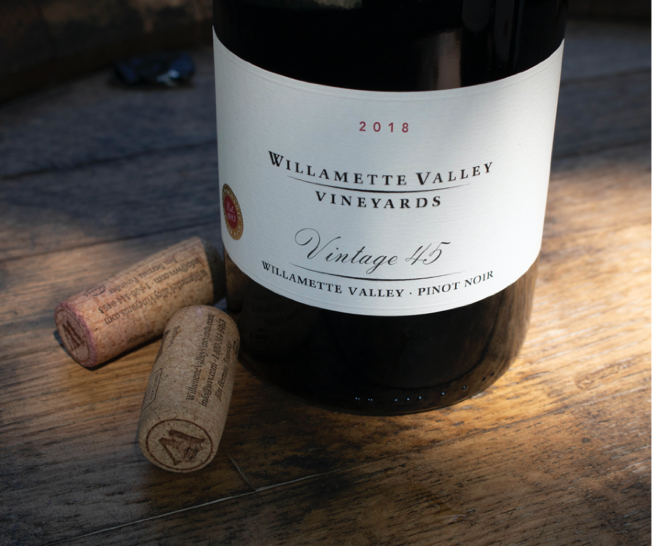
2016 Lavinea Tualatin Estate Vineyard Tualatin Hills Pinot Noir
13.1% alc., 239 cases, $65. Dry-farmed,
own-rooted Pommard planted in 1974 and Dijon 667 clones. Harvest Brix 23.6º. Spontaneous native yeast
fermentation. Aged in 27% new oak barrels.
·
Moderately light garnet color in the glass. Leading off are aromas
of red cherry, sous-bois, and a touch of oak. Light to mid-weight in style, featuring leaner red cherry and
strawberry flavors embellished with a mantel of oak. Elegant in character, with a long, lip-smacking finish.
Score: 91
2018 Lavinea Tualatin Estate Vineyard Tualatin Hills Pinot Noir
13.8% alc., $65. Harvest Brix 23.8º.
Spontaneous native yeast fermentation with no inoculations. Aged in mixed oak cooperage, 30% new.
·
Moderately light garnet color in the glass. Reserved but pleasant aroma of red fruit leather. More fruit-forward
then the 2016 vintage with charming fruit flavors of cherry and strawberry. There is a pleasing savory side to
this wine with both fruit and savory nuances mingling nicely. This is a poised wine with admirable elegance and
a very long finish redolent with red fruits.
Score: 93



